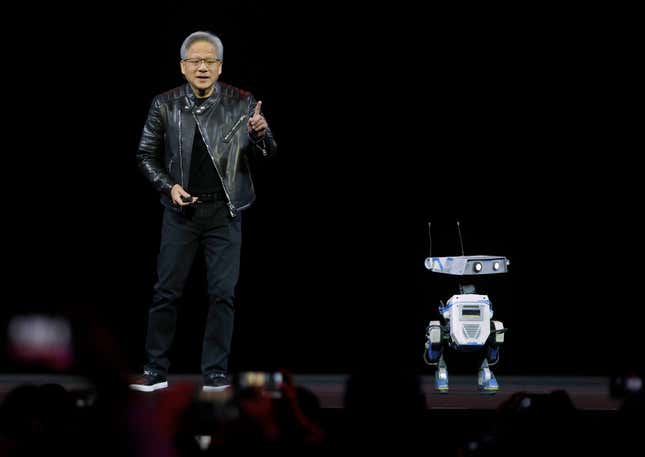
In This Story
If you missed Nvidia’s (NVDA-1.54%) keynote at Computex 2025, here’s the short version: AI is no longer just a tool — it’s the infrastructure of the future. Robots, desktops, smart cities, physics engines, and even national computing grids — all of it, Nvidia says, will be built on artificial intelligence.
Speaking in Taipei at Asia’s largest electronics expo, CEO Jensen Huang laid out a sweeping vision of the company’s future — one where Nvidia isn’t just enabling AI, it’s helping build a world run by it.
Leading the announcements was the DGX Spark, a compact AI supercomputer built for individual developers, researchers, and students. Think of it as a desktop-sized version of Nvidia’s massive Blackwell-based systems, with enough power to train and fine-tune large AI models locally — no cloud access required.
It’s the plug-and-play engine for what Huang called “AI-native” users — those who want high-performance AI development at their fingertips. Major OEMs such as Dell (DELL-3.07%), ASUS, Lenovo, MSI, and Gigabyte are already lined up to offer Spark systems tailored for different segments of the market.
That’s just one node in Nvidia’s broader push toward what Huang calls “AI factories” — purpose-built computing environments where massive amounts of data are processed and AI-based systems are created, refined, and deployed.
To support this expansive vision, Nvidia launched something Huang said was “very special” and “one incredible ingredient” that has been missing: NVLink Fusion, an initiative that allows its GPUs to work seamlessly with third-party CPUs and custom AI chips. That means companies such as Qualcomm (QCOM+0.20%), Fujitsu, Marvell (MRVL-1.67%), and Alchip Technologies can plug into Nvidia’s ecosystem — a notable shift for a company long known for its tightly integrated stacks.
“I’ll let all of our partners price it for themselves, but one thing’s for sure: Everybody can have one for Christmas,” Huang said.
But this wasn’t just a cloud-computing conversation. It was one about bringing AI into the physical world.
Nvidia doubled down on “physical AI” — the idea that machines should understand and interact with the laws of the real world. Huang talked about Isaac Groot N1 (announced in March), which is a foundational model for robotics that gives humanoid robots the ability to reason, plan, and perceive their surroundings.
“The age of generalist robotics has arrived with breakthroughs in mechatronics, physical AI, and embedded computing — just in time as labor shortages limit worldwide industrial growth,” Huang said.
One challenge in robotics today is data scarcity, especially high-quality, physical interaction data. Nvidia hopes to answer this problem with Cosmos, a photorealistic simulator that creates synthetic data by observing human behavior in virtual environments. Isaac Groot N1, combined with Cosmos, means developers could now create massive amounts of training data in virtual worlds before rolling out systems in the real one.
Developers can now use Groot Dreams — a tool built on Cosmos — to create “future world states,” Huang said, by prompting the model with new tasks and images. This makes it possible to simulate millions of training scenarios before deploying robots in the real world.
To help ground those dreams in physical reality, Nvidia will use the recently announced Newton, an open-source physics engine built in collaboration with Google DeepMind (GOOGL-1.57%) and Disney Research (DIS-1.33%) that will be open sourced in July. It’s designed to help AI systems understand real-world dynamics such as gravity, collisions, and torque — bridging the gap between code and physical context.
“It’s incredible what it can do,” Huang said. “It’s completely GPU accelerated. It’s differentiable, so you could learn from experience. It is incredibly high fidelity.”
Meanwhile, Nvidia is planting deeper roots in Asia with Nvidia Constellation, a new AI-focused hub in Taipei’s Beitou Shilin Science Park. It’s a strategic play — tapping into Taiwan’s world-class semiconductor ecosystem while deepening Nvidia’s presence in the global AI supply chain.
Taipei’s mayor, Chiang Wan-an, attended Huang’s keynote and later told reporters that the city fully supports Nvidia’s plans and is ready to offer whatever help is needed.
One of the most strategically significant announcements came near the close of Huang’s keynote: a joint effort to build a national AI supercomputer in Taiwan. Nvidia will partner with Taiwan Semiconductor Manufacturing Company (TSM+0.63%) (TSMC), Foxconn, and the Taiwanese government to create a cutting-edge AI system for the island.
This project aims to integrate AI deeply into urban infrastructure, transforming cities such as Taipei into smart ecosystems powered by advanced computing. The initiative underscores Nvidia’s goal of embedding AI — and thus, its products — into the fabric of daily life, from autonomous vehicles to intelligent public services.
Huang’s overall message was unmistakable: AI is no longer just software. It’s infrastructure. It’s automation. It’s everywhere. And Nvidia wants to not only build just the silicon — it wants to build but the systems, the software, and the global footprint to power it all.